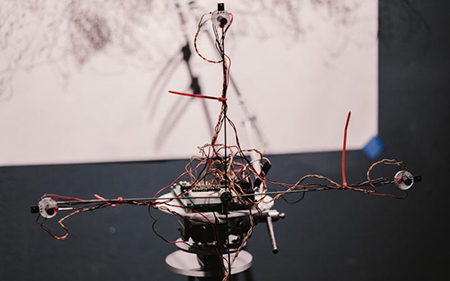
Continuing through February 23, 2018
The pioneering mind of 20th century composer John Cage is the impetus for “Drawn from a Score." His use of chance and inconsistency led to inventive music, and nonstandard perceptions, connecting disparate thoughts of distinct disciplines. Based on coding — original instructions — in technology, music, science and art, the displays bubble over with possibilities once never perceived, now believable and real. Filling in information gaps, the take-away is that disparate perceptions can expand and connect, becoming a unification of knowledge. The twenty artists here reveal an amazing range of experimentations — use plotters, punch cards, FORTRAN to contemporary computer programming, lighting, sound and more.
Alison Knowles presents a poetry machine, “A House of Dust” (1967). A dot-matrix printer prints continuous computer-generated poetry. It spawns nonsensical words that randomly produces rubbish, intelligent, humorous, or eloquent poetic expressions. David Bowen conjures one of the hits of the show, an “Infrared Drawing Device” (2003) sensors that allow a human hand, not touching paper or charcoal, to make random drawings based on hand motions in the air. Sol LeWitt’s “Wall Drawing 76” (1971) was reproduced by UCI students. On a large white wall, meticulous and close vertical lines of various lengths are drawn with black graphite. Known for his Minimal and Conceptual explorations, the work conveys LeWitt’s idea to allow others to execute his creative process. Shirley Shor's “Landslide” (2004) continually generates animated images projected downward onto a sandbox below. The piece speeds up time, conveying the beauty of a continuous changing topography. in “Enough is Plenty" (1969) Frederick Hammersley uses a punched card process to produce ink drawings on paper composed of complex shapes and patterns. This was one of the first computers designed to produce visual art. Lastly, “Reunion” (1968-2017) is a recreation of a collaboration between John Cage, Marcel Duchamp and Teeny Duchamp. An electronic musical chess board emits various sounds as chess pieces are moved, taken away, or added. In this way, motion is choreographed and translated into an improvised musical score.
